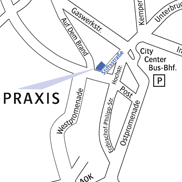Contact
Stiftsstraße 21
52525 Heinsberg
Phone +49 (0)2452 / 924450 Fax +49 (0)2452 / 9244579
info radiologie-heinsberg.de

Periradicular therapy
The PRT is an approved, low-risk treatment for the therapy of complaints such as pain, paraesthesia or numbness, which originate from nerve root irritation. You should be aware of the process and the typical risks of such a therapy before deciding whether or not to go aheadt. The education form is designed to give you an overview about the PRT procedure.
How is the PRT carried out?
The patient is positioned in an appropriate position for the joints which require treatment. This can be in a supine position (for treatment of the cervical spine) or in abdominal position (for treatment of the thoracic or lumbar spine). After examination of the punctuation spot with the computer tomograph it will be anaesthetised. Then a thin needle will be positioned near the nerve root. The position of the needle and the distribution of the medication can be monitored in the CT scanner by use of a dilution with water and a small amount of contrast medium. Afterwards the medication is injected (containing 4-8ml local anaesthetic and 20mg cortisone crystal suspension). After the injection of the medicine the needle will be removed.
The treatment is now completed. It can be repeated, if required, multiple times at an interval of several days.
What should the patient be mindful of after the periradicular therapy?
The local anaesthetic can cause a feeling of weakness in arms or legs. Therefore you have to stay in the surgery for another hour after the treatment. You should not take part in road traffic actively on the day of the treatment, please have someone to pick you up.
If intense pain or mental aberration (e.g. dizziness, nausea, vomiting) occurs, please inform the doctor immediately.
Which risks have to be taken into account?
The PRT is a low-risk and nearly free from side effects treatment. In extremely rare cases it can lead to complications nevertheless.
To name but a few:
- Rarely bruises occur in the injection area
- Extremely rarely the pain is intensified after the first or second treatment session. If this happens, inform your doctor immediately.
- Extremely rarely the medicine causes allergic reactions (e.g. flushes, itches, breathing trouble, cardiovascular problems up to death)
- Extremely rarely an impairment of the nerves through the needle or medicine can occur
- It can lead to intermenstrual bleeding or abnormal oestrous cycle with women

